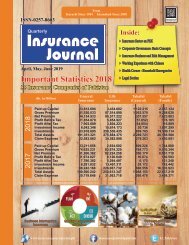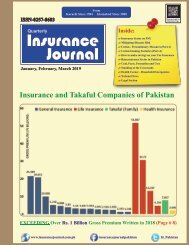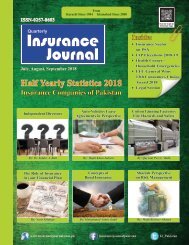Insurance Journal (2nd Quarter 2021)
You also want an ePaper? Increase the reach of your titles
YUMPU automatically turns print PDFs into web optimized ePapers that Google loves.
Guest Contribution
long-term growth and replenish
macroeconomic resilience. This
will require investment and
commitment to facilitate change
across many different areas,
i n c l u d i n g t h e b u i l d i n g o f
sustainable infrastructure, a broader
roll-out of the digital economy and
the transition to low-carbon energy.
Governments also need to act to
reduce inequality and build human
capital through education and
training. Labour markets must
become more efficient so that more
people have the chance to
participate in the workforce and
make up for personal losses from the
crisis.
Mind the Protection Gap
Governments absorbed the bulk of
t h e p a n d e m i c s h o c k w i t h
emergency spending on public
health needs. But as the Index
shows, the global protection gap –
the difference between levels of
insurance cover and expected losses
– is widening at a time when
governments lack the resources to
make good the difference. This
leaves societies dangerously
exposed to potentially devastating
losses.
Last year, the global protection gap
for health, mortality and natural
catastrophes rose to USD 1.4 trillion
amidst the pandemic. The biggest
gap remains in natural catastrophe
cover, with 76% of protection needs
uninsured globally. The insurance
gap for natural disasters is smallest
in Western Europe.
The global mortality protection gap
stands at USD 408 billion. In 2020,
it increased mainly as a result of a
drop in financial assets and growing
household debt amidst the
pandemic crisis. The gap translates
into a mortality resilience index of
45.8%, meaning that well under half
of the funds needed to maintain a
household after the death of its
primary breadwinner are protected
by assets like life insurance or social
security.
An Unequal Burden
The impact of the pandemic on
individuals and households varies
depending on the quality of health
infrastructure and the success of
government containment policies.
More than two-thirds of the gap last
year came from emerging markets,
particularly emerging Asia.
Poorer countries face a double
whammy: COVID-19 has exposed
wide differences in the availability
of intensive care beds, so they face
the challenge of scaling up
provision on very limited budgets.
At the same time, they need to
protect those who become sick from
often crippling healthcare costs.
In low-income countries, out-ofpocket
expenditure typically
represents more than 40% of all
household healthcare spending,
compared with only 24% in
advanced markets, and leaves
households vulnerable to financial
stress. Affordable health insurance
can play a central role in enhancing
protection and reducing this
financial risk.
Insurance is Key
By helping to close the protection
gap, re/insurers will have a central
role in putting vulnerable
households on a more secure
footing and making the world more
resilient.
Technology and data are key assets
in efforts to reach more people
across the world, especially those
that have so far been unable to
access or afford insurance products.
Digitization not only makes it easier
for people to obtain cover, but also
saves costs for insurers in areas such
as onboarding clients, underwriting
and settling claims.
The re-insurance industry can also
promote the creation of sustainable
infrastructure, both by offering risk
cover and choosing how to invest
funds. For example, re/insurers are
already supporting growth in the
renewable energy industry and
becoming increasingly active in
supporting nascent technologies
like carbon removal, which will
accelerate the transition to a net zero
economy.
A Shared Priority
Yet, while the insurance industry
can contribute to greater stability in
a fragile world by taking on some of
the risk, it's clear that it cannot
achieve this alone.
T h e g l o b a l p a n d e m i c h a s
accentuated the gap between the
rich and poor. It has starkly laid bare
the need for governments to focus
on rebuilding the social contract and
promoting social cohesion. Social
equity – and its heart, creating equal
opportunities for all – will be a
defining feature of a more resilient
world.
Making insurance more widely
available and affordable will be
essential. But re/insurers and
leaders in business and government
must make resilience a shared
priority.
It is by working together to foster
sustainability, innovation and
opportunity that resilience can be
rebuilt – securing future gains and
leading to a better and more
prosperous tomorrow for everyone.
Courtesy: Salman Saif
Insurance Journal April, May, June 2021
21
Find us at: www.insurancejournal.com.pk — www.facebook.com/insurancejournalpakistan

















